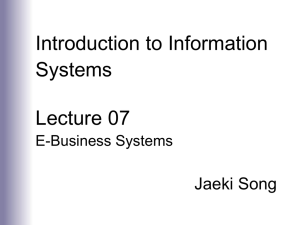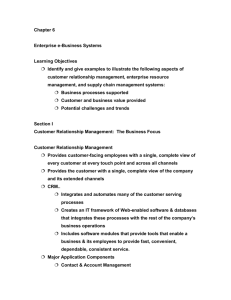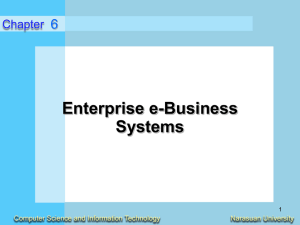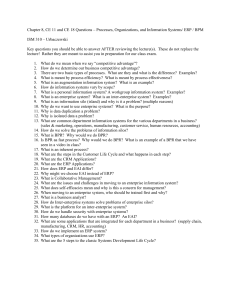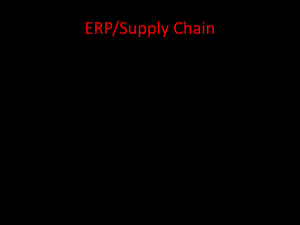Cross-Functional Information Systems
advertisement
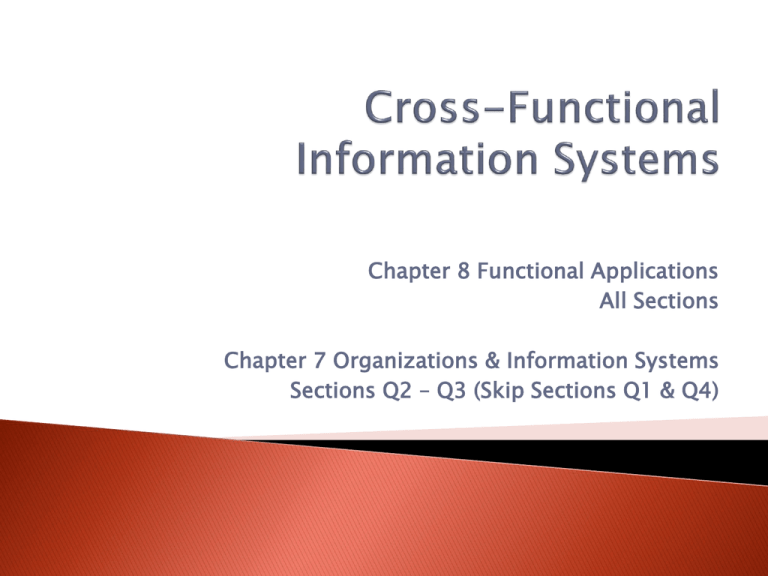
Chapter 8 Functional Applications All Sections Chapter 7 Organizations & Information Systems Sections Q2 – Q3 (Skip Sections Q1 & Q4) Today’s Topic Security Hardware & Software IS Basics Information Quality Types of IS Systems Development PowerPoint Spreadsheet Design Database Processing & Design Telecommu -nications Functional, Crossfunctional & Interorganizational E-commerce Excel Access Business Intelligence Organizational IS Functional Functional Units Crossfunctional Problems CRM ERP & EAI Understand the differences between functional and cross-functional systems. Know the characteristics, benefits and problems associated with CRM & ERP. Distinguish between ERP and EAI. Sales Operations Human Resources Manufacturing Accounting Data duplication, data inconsistency Disjointed applications Limited information and lack of integrated information Isolated decisions Increased expense Organize around integrated activities that span functional units. Underlying business processes are changed. Software is developed to support improved business processes. Customer Relationship Management (CRM) Enterprise Resource Planning (ERP) Enterprise Application Integration (EAI) A typical dissatisfied customer will tell 8-10 people about his or her experience. 75% of complaining customers will do business with the company again if it quickly takes care of a service snafu. A company can boost profits 85% by increasing its annual customer retention by only 5% It costs 6 times more to sell to a new customer than to sell to an existing customer. The odds of selling a product to a new customer are 15% whereas the odds of selling a product to an existing customer are 50%. Customer-centric philosophy Cross-functional IS Provides all employees with tools needed to respond to any customer need Thorough data collection “In terms of customer service, they are a revolutionary company.” “Seamless process... Won’t have any hesitation the next time I order from them.” “Take care of the customer no matter what. They just want to please you.” http://www.youtube.com/watch?v=MTWLLnRS3 5Q Identify, target and retain most profitable customers. Customize products and services to each customer. Identify customer desires. Meet customers needs. Understand customers’ wants and needs Change appropriate business processes not just IT Prepare customers and employees for change Cross-functional IS Cooperative, integrated philosophy Centralized database Formal approach Very expensive More Efficiency Higher Quality Lower Costs Enterprise Agility Better Decision-making / Higher Profits Project complexity Participation by appropriate employees User training Integrates existing information systems with software interfaces for the purposes of: ◦ sharing data ◦ increasing communication ◦ making a gradual transition to ERP Functional •Sales •Operations Interorganizational Crossfunctional •CRM •SCM •EAI •Manufacturing •Human Resources •Accounting ERP



